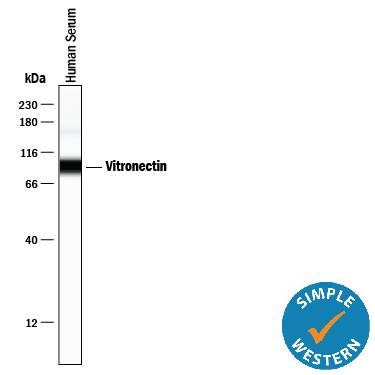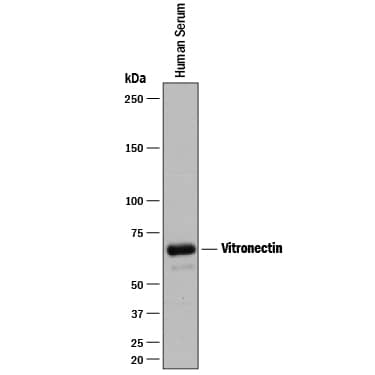Human Vitronectin Antibody
R&D Systems, part of Bio-Techne | Catalog # MAB2349

Key Product Details
Species Reactivity
Validated:
Cited:
Applications
Validated:
Cited:
Label
Antibody Source
Product Specifications
Immunogen
Specificity
Clonality
Host
Isotype
Scientific Data Images for Human Vitronectin Antibody
Detection of Human Vitronectin by Western Blot.
Western blot shows human serum. PVDF membrane was probed with 0.1 µg/mL of Mouse Anti-Human Vitronectin Monoclonal Antibody (Catalog # MAB2349) followed by HRP-conjugated Anti-Mouse IgG Secondary Antibody (Catalog # HAF007). A specific band was detected for Vitronectin at approximately 65 kDa (as indicated). This experiment was conducted under reducing conditions and using Immunoblot Buffer Group 1.Vitronectin in Human Bladder.
Vitronectin was detected in immersion fixed paraffin-embedded sections of human bladder using Mouse Anti-Human Vitronectin Monoclonal Antibody (Catalog # MAB2349) at 8 µg/mL overnight at 4 °C. Tissue was stained using the Anti-Mouse HRP-DAB Cell & Tissue Staining Kit (brown; Catalog # CTS002) and counterstained with hematoxylin (blue). Specific labeling was localized to endothelial cells. View our protocol for Chromogenic IHC Staining of Paraffin-embedded Tissue Sections.Detection of Human Vitronectin by Simple WesternTM.
Simple Western lane view shows human serum, loaded at 0.2 mg/mL. A specific band was detected for Vitronectin at approximately 85 kDa (as indicated) using 5 µg/mL of Mouse Anti-Human Vitronectin Monoclonal Antibody (Catalog # MAB2349). This experiment was conducted under reducing conditions and using the 12-230 kDa separation system.Applications for Human Vitronectin Antibody
Immunohistochemistry
Sample: Immersion fixed paraffin-embedded sections of human bladder and breast
Simple Western
Sample: Human serum
Western Blot
Sample: Human serum
Reviewed Applications
Read 2 reviews rated 4.5 using MAB2349 in the following applications:
Formulation, Preparation, and Storage
Purification
Reconstitution
Formulation
Shipping
Stability & Storage
- 12 months from date of receipt, -20 to -70 °C as supplied.
- 1 month, 2 to 8 °C under sterile conditions after reconstitution.
- 6 months, -20 to -70 °C under sterile conditions after reconstitution.
Background: Vitronectin
Vitronectin is a 71 kDa secreted glycoprotein produced by the liver and tumor cells. In blood, Vitronectin is called serum spreading factor. In the extracellular matrix, its function is determined by binding partners such as PAI-1, complement factors, integrins (notably alphav beta3) and thrombin. The 459 aa mature human Vitronectin shows 74% amino acid identity with mouse Vitronectin and contains somatomedin B-like and hemopexin-like domains, an RGD motif, a basic heparin-binding domain and sulfated tyrosines. Unbound Vitronectin is a monomer that may be cleaved to form a dimer of 65 kDa and 10 kDa components.
Alternate Names
Gene Symbol
Additional Vitronectin Products
Product Documents for Human Vitronectin Antibody
Product Specific Notices for Human Vitronectin Antibody
For research use only


